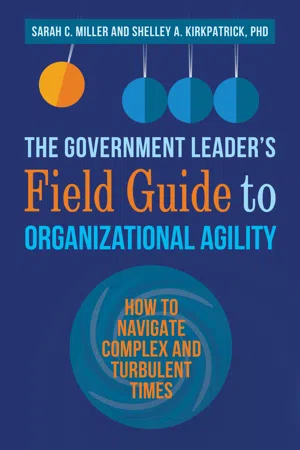
The Government Leader's Field Guide to Organizational Agility
How to Navigate Complex and Turbulent Times
- 288 pages
- English
- ePUB (mobile friendly)
- Available on iOS & Android
The Government Leader's Field Guide to Organizational Agility
How to Navigate Complex and Turbulent Times
About This Book
This book is the first to fully adapt the principles of agility for government leaders who want to make their organizations more effective and nimbler while better serving their public mission. This practical resource will equip government leaders with evidence-based, hands-on guidance for transforming their organizations, enabling them to better serve the public and their customers. While many books on organizational agility are available for leaders in for-profit companies, this is the first one tailored to the unique limitations and requirements government leaders face. Public servants are increasingly asked to do more with less and must also find a way to accomplish their mission while balancing constant change. New laws are passed that impact their agencies, new technologies are introduced, and unexpected events occur. Government leaders at all levels are often in a position for only two to four years, rotating within and across agencies as they gain experience. They have a relatively short amount of time to learn a new role, make changes, and then begin seeking out their next opportunity. This guide will help leaders weather the storm of that constant change so they can help their agencies realize their missions to provide services and be better stewards of taxpayer or donor dollars.
Frequently asked questions
Information
ONE
Constant Change Requires a Different Way of Organizing
Table of contents
- Cover
- Title Page
- Copyright Page
- Dedication
- Contents
- List of Tools
- Preface
- Chapter 1 | Constant Change Requires a Different Way of Organizing
- Chapter 2 | Build a Foundation of Psychological Safety
- Chapter 3 | Lead with Agility
- Chapter 4 | Make Decisions at the Right Level
- Chapter 5 | Promote Collaborative Learning
- Chapter 6 | Create Stability
- Chapter 7 | Create Flexibility
- Chapter 8 | Encourage the Routines
- Chapter 9 | Invest in People
- Chapter 10 | Putting It All Together
- Appendix: Organizational Agility Framework
- References
- Acknowledgments
- Index
- About the Authors
- About the Contributors

